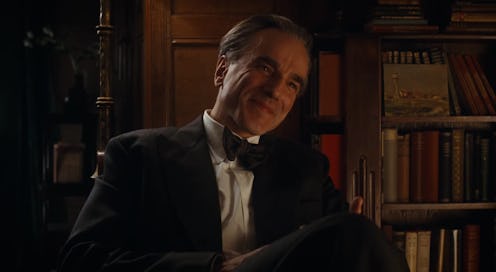Fashion
The Real Story Behind Daniel Day-Lewis' Unforgettable 'Phantom Thread' Character
Paul Thomas Anderson's Phantom Thread is a fascinating contest of wills hidden in the tired yet Hollywood-beloved tale of a young muse inspiring a genius man. The film's gorgeous '50s visuals reflect the fussiness and perfection of Reynolds Woodcock, the famous designer everyone's world centers around. Played by Daniel Day-Lewis, Woodcock is elegant, finicky, demanding, and selfish, living in a world of women but never really acknowledging them, until his latest muse Alma proves more than a match for his attitude. Anderson is known for inventing rich, believable characters, and Day-Lewis does intensive research for every character he plays. But is Phantom Thread's Reynolds Woodcock based on a real person, or is he a creation invented solely for the film?
It turns out the inspiration for Woodcock came from some surprising sources. Phantom Thread is centered around a '50s fashion house, so of course Woodcock's character was partly inspired by designers of the time. In an interview with The Seattle Times, costume designer Mark Bridges said that the House Of Woodcock's look was inspired by midcentury titans of fashion like Charles James, America's First Couturier, Christian Dior's wildly influential reaction to wartime rationing, the New Look, and most of all, Cristóbal Balenciaga, who Dior himself referred to as "the master of us all."
What fascinated Anderson about Balenciaga wasn't so much his fashion, but his life. In an interview with Entertainment Weekly, the filmmaker said, "I generally didn’t have that much knowledge or interest in the fashion world until I started finding out a little bit about a guy named Cristóbal Balenciaga." Balenciaga's focus on art over publicity (according to a Telegraph article, he only gave one interview in his life and was so reclusive many people thought he didn't actually exist), and appreciation for clients who understood his artistry, are reflected in Woodcock. In one scene, he violently takes a dress back from a woman who behaves boorishly while wearing it.
Day-Lewis also took inspiration directly from the designer. In an interview with W magazine, the actor said he needed to sew a piece of couture from scratch to understand Woodcock's character. The designer he chose to replicate? Balenciaga. Using his wife Rebecca Miller as a (very patient) fit model, Day-Lewis recreated a Balenciaga sheath dress inspired by a school uniform in flannel gray. The work gave him a deeper appreciation for Balenciaga's genius. In the W interview, the actor said, "There is nothing more beautiful in all the arts than something that appears simple. And if you try to do any goddamn thing in your life, you know how impossible it is to achieve that effortless simplicity.”
Day-Lewis himself contributed immensely to Woodcock's character. In the aforementioned Seattle Times article, costume designer Bridges said he provided the movie's star with an extensive wardrobe, and left it up to him to choose what he thought Woodcock would wear. Of a scene where Woodcock just wants a quiet night in, Bridges said, “Paul and I waited with bated breath to see what was going to come down those stairs!”
The most surprising influence on Woodcock's character was Anderson himself. While Balenciaga inspired the director to work in the world of fashion, the mental tug-of-war between Alma and Woodcock came straight from the director's own experience. In an interview with the Chicago Tribune, Anderson said that a specific moment from life inspired Phantom Thread. While laid up with the flu for several days, the director saw "how much my wife was enjoying having me relatively helpless. Then I started thinking, wouldn’t it kind of … suit her to keep me this way, you know, from time to time?"
The ongoing dynamics of a long-term relationship are also based on experience; Anderson and multitalented actor Maya Rudolph have been married over 17 years, with four children. But where Anderson and Woodcock differ is the director's overt affection for his wife. In a Variety article, the author said of Anderson, "He speaks with great tenderness about his marriage and his four children, so I’m going to make a daring leap and assume that he’s not very much like the characters he depicts." Woodcock and Alma's dynamic is one where neither can admit how much they need the other, without some proxy as excuse ("muse" for Woodcock and "sick patient" for Alma).
While Woodcock is a fictional mix of actual designers, Lewis's preferences, and Anderson's relationships, the genius of the film is how absolutely real he seems. The small details and gestures, the nuances and quirks of behavior, make him seem as legitimate as any of his influences.
